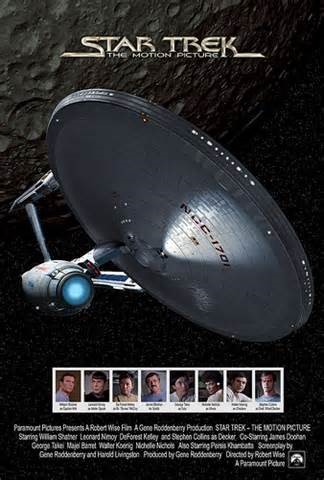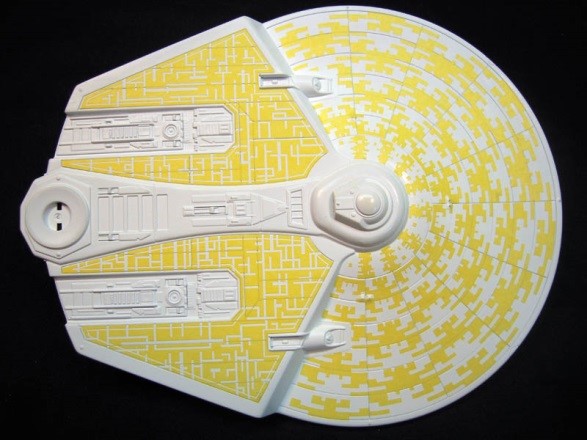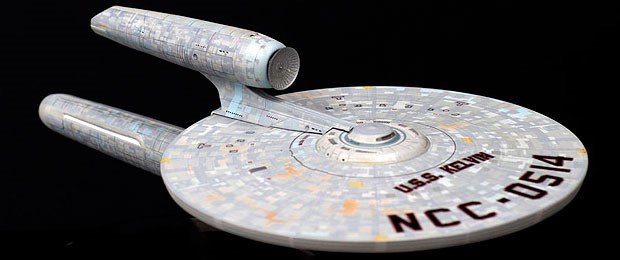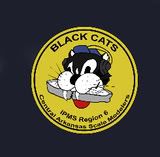Article by: Brent Bristow
For a bit of history, when Star Trek began airing in 1966, the ships appeared to be uniformly gray or white on low resolution 1960s and ‘70s televisions. (The correct color of the Enterprise is a hotly debated topic that will not be discussed here!) The original series went off of the air in 1969, but was revised in the movie series in 1979. After the influence of the Star Wars films, and other series, such as Space: 1999 and Battlestar Galactica, producers decided to revamp the Enterprise to include aztecing patterns to simulate the hull plating under the paint, but mostly to give the ship more detail for the big screen. This has been standard procedure on the films and TV series for the next 35 years, with more and more complex patterns being added to new ships.
1. Decals: In the early 2000s, as modelers began printing their own decals, many individuals started designing their own aztecing decals, and eventually started selling them. Aftermarket decals for several ships can be ordered at Starship Modeler and Cult TV Man. Round 2, who owns most of the rights to produce Trek kits, has also been including aztecing decals with many of their kits in the past few years, particularly the smaller scale ships (1/2500, 1/1000). Round 2 also offers a few aftermarket sets for some of its kits, such as the U.S.S. Reliant.
Pros: These are very detailed and very accurate (or pretty darn close, anyway). They will provide the greatest amount of detail of any of the options, and with the least amount of work. Most of these decal sets are usually fairly easy to obtain. Also, no research is needed.
Cons: While some may feel that using decals is not a challenge, we all know that decals don’t always cooperate, and this is a pretty extensive job. You also have little to no control over the colors used. Some sets have multiple color options, but this is very limited. Some of them can be a little too dark to blend with your base coat. Be aware that aftermarket decals can sometimes be pricey. Perhaps the biggest disadvantage is that your ships may end up looking like everyone else’s. If are going for screen accuracy, that may not be a problem.
Pros: You can control the colors and contrast for better blending. You can have an accurately marked ship but still have some individual artistry. If done properly, it can look very realistic. Again, no extensive research is needed.
Cons: Applying the masks can be almost as time consuming as applying the decals, and then you still have to paint. Also, as these are only available as an aftermarket product, it can be expensive. There won’t be quite as much detail as the decals. These are difficult to find for smaller scale ships.
Pros: This is very cost effect and allows you to customize your pattern a bit more. This is for those that have way more time than money.
Cons: This is the most time consuming of the methods, and will require a lot of research. (Of course, that just means watching more Trek!) If you are using a free template you find, you may want to verify its accuracy. Cutting and placing the tape be tricky, and frustrating. Smaller scale ships can be exceedingly difficult.
Pros: This is perhaps the least time consuming method, depending on how involved you want to get with it. It also allows for much greater artistic freedom and may (no guarantees!) make your ship stand out. This method can be used for many other non-Trek model vehicles as well.
Cons: Your ship will NOT be an accurate representation of the one used on screen. You also have to be careful to not overdo it. Getting too heavy handed can cause it to look messy. This will also not work for ships with specific distinctive patterns, such as the Enterprise-E.
If you haven’t picked up a Trek model in a while because you are afraid to deal with aztecing, maybe now is the time to give it another chance. You have several options to try to achieve the effect you want, and you may remember what you loved these ships in the first place. So, until next time, live long and prosper!







